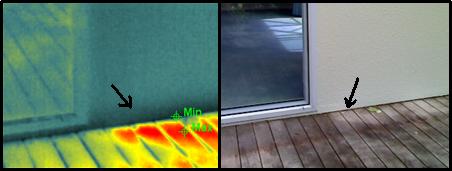One of the most common questions we get asked, is “What are the most common causes of leaky homes?”
There are several things to look for when buying a home to determine if it could be a leaky building. There are several different telltale design faults that contribute to houses leaking… and here is just one of them:

In the righthand photo, you will see how the cladding runs down and touches the deck. In the lefthand infrared photo, you will see a dark shade running across the base of the cladding, indicating signs of moisture ingress at the base of the wall.
The new building code stats you need ‘ground clearence’ (a gap) between the bottom of the cladding and the ground (or in this case, the deck). What’s happened is the above photos, is water has run across the deck and under the base of the cladding. Because the deck is touching the cladding, the water has soaked back up the cladding (Commonly referred to as capillary reaction or ‘wicking’), and into the bottom plate of the timber frame behind the wall.
In addition, there is only a small height difference between the inside floor level and the outside deck level, therefore the water doesn’t have far to wick into the timber frame of the wall.
The above scenario is a common problem in homes built in the ‘leaky home era’, and as a result has caused many homes to sustain serious moisture damage within the building envelope.
In most cases you will not know if water has penetrated the wall unless you have the correct equipment to indicate if there could be an moisture issue… as most of ‘subtle’ leaking problems are not visible to the human eye.






